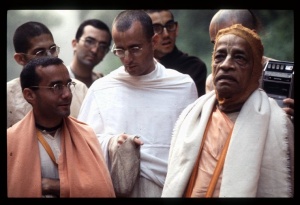CC Madhya 21.60 (1975): Difference between revisions
(Vanibot #0027: CCMirror - Mirror CC's 1996 edition to form a basis for 1975) |
(Vanibot #0020: VersionCompareLinker - added a link to the Version Compare feature) |
||
| Line 2: | Line 2: | ||
<div style="float:left">'''[[Sri Caitanya-caritamrta (1975)|Śrī Caitanya-caritāmṛta (1975)]] - [[CC Madhya (1975)|Madhya-līlā]] - [[CC Madhya 21 (1975)|Chapter 21: The Opulence and Sweetness of Lord Śrī Kṛṣṇa]]'''</div> | <div style="float:left">'''[[Sri Caitanya-caritamrta (1975)|Śrī Caitanya-caritāmṛta (1975)]] - [[CC Madhya (1975)|Madhya-līlā]] - [[CC Madhya 21 (1975)|Chapter 21: The Opulence and Sweetness of Lord Śrī Kṛṣṇa]]'''</div> | ||
<div style="float:right">[[File:Go-previous.png|link=CC Madhya 21.59 (1975)|Madhya-līlā 21.59]] '''[[CC Madhya 21.59 (1975)|Madhya-līlā 21.59]] - [[CC Madhya 21.61 (1975)|Madhya-līlā 21.61]]''' [[File:Go-next.png|link=CC Madhya 21.61 (1975)|Madhya-līlā 21.61]]</div> | <div style="float:right">[[File:Go-previous.png|link=CC Madhya 21.59 (1975)|Madhya-līlā 21.59]] '''[[CC Madhya 21.59 (1975)|Madhya-līlā 21.59]] - [[CC Madhya 21.61 (1975)|Madhya-līlā 21.61]]''' [[File:Go-next.png|link=CC Madhya 21.61 (1975)|Madhya-līlā 21.61]]</div> | ||
{{CompareVersions|CC|Madhya 21.60|CC 1975|CC 1996}} | |||
{{RandomImage}} | {{RandomImage}} | ||
==== TEXT 60 ==== | ==== TEXT 60 ==== | ||
<div class="verse"> | <div class="verse"> | ||
:kṛṣṇa | :kṛṣṇa kahena--'kon brahmā, ki nāma tāhāra?' | ||
:dvārī | :dvārī āsi' brahmāre puche āra bāra | ||
</div> | </div> | ||
| Line 18: | Line 17: | ||
<div class="synonyms"> | <div class="synonyms"> | ||
kṛṣṇa kahena—Kṛṣṇa said; kon brahmā—which Brahmā; ki nāma tāhāra—what is his name; dvārī | kṛṣṇa kahena—Kṛṣṇa said; kon brahmā—which Brahmā; ki nāma tāhāra—what is his name; dvārī āsi'-the doorman, coming back; brahmāre—to Lord Brahmā; puche—inquires; āra bāra—again. | ||
</div> | </div> | ||
| Line 25: | Line 24: | ||
<div class="translation"> | <div class="translation"> | ||
"When Kṛṣṇa was so informed, He immediately asked the doorman, 'Which Brahmā? What is his name?' The doorman therefore returned and questioned Lord Brahmā. | |||
</div> | </div> | ||
| Line 32: | Line 31: | ||
<div class="purport"> | <div class="purport"> | ||
From this verse we can understand that Brahmā is the name of the post and that the person occupying the post has a particular name also. From | From this verse we can understand that Brahmā is the name of the post and that the person occupying the post has a particular name also. From Bhagavad-gītā: imaṁ vivasvate yogam. Vivasvān is the name of the present predominating deity of the sun. He is generally called Sūrya, the sun-god, but he also has his own particular name. The governor of the state is generally called rāja-pāla, but he also has his own individual name. Since there are hundreds and thousands of Brahmās with different names, Kṛṣṇa wanted to know which of them had come to see Him. | ||
</div> | </div> | ||
Latest revision as of 13:59, 27 January 2020

A.C. Bhaktivedanta Swami Prabhupada
TEXT 60
- kṛṣṇa kahena--'kon brahmā, ki nāma tāhāra?'
- dvārī āsi' brahmāre puche āra bāra
SYNONYMS
kṛṣṇa kahena—Kṛṣṇa said; kon brahmā—which Brahmā; ki nāma tāhāra—what is his name; dvārī āsi'-the doorman, coming back; brahmāre—to Lord Brahmā; puche—inquires; āra bāra—again.
TRANSLATION
"When Kṛṣṇa was so informed, He immediately asked the doorman, 'Which Brahmā? What is his name?' The doorman therefore returned and questioned Lord Brahmā.
PURPORT
From this verse we can understand that Brahmā is the name of the post and that the person occupying the post has a particular name also. From Bhagavad-gītā: imaṁ vivasvate yogam. Vivasvān is the name of the present predominating deity of the sun. He is generally called Sūrya, the sun-god, but he also has his own particular name. The governor of the state is generally called rāja-pāla, but he also has his own individual name. Since there are hundreds and thousands of Brahmās with different names, Kṛṣṇa wanted to know which of them had come to see Him.